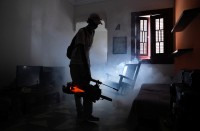A cholera outbreak is feared in coming months in Syria, where other water-borne diseases such as hepatitis A and typhoid are on the rise due to poor sanitation, the World Health Organization (WHO) warned yesterday.
Safe drinking water is available at about one-third of the level it was before the conflict erupted nearly five years ago, and supplies are cut-off to punish civilians at times, it said.
Some 31,460 cases of hepatitis A were reported in Syria last year and more than 1,000 cases have been recorded per week since January, said Dr. Elizabeth Hoff, WHO representative in Syria.
“What is the main fear that WHO has as we are moving forward is really the risk of water-borne diseases, because quite clearly we have seen this, also during the winter season, which is not really often the case. We have in 2014, 31,460 cases of hepatitis A reported and this, normally, we are seeing when the weather is warmer and so on, but it just tells you that people no longer have the same access to safe drinking water as before,” Hoff told a news briefing in Geneva.
“We are going into the warmer season, what we are particularly concerned about, which has not happened in Syria at all so far since the crisis started almost five years ago is cholera. This is our main fear, but so far we haven’t seen it, but quite clearly the situation is going much more critical and we have also seen that water, and WHO has had press releases on this, that water has been used for political dividends and have been turned off to certain areas and that leads people to drink water from unsafe sources,” she added.
Cholera, an intestinal infection often linked to contaminated drinking water, causes severe diarrhea and vomiting, leaving small children especially vulnerable to death from dehydration, according to the U.N. health agency.
Infectious diseases thrive in overcrowded conditions and poor hygiene, according to the WHO. It appealed for $116 million to provide medicines and health care services to 12.2 million people across Syria this year.
Some 25,000 people are wounded each month, requiring surgical supplies, safe blood transfusion and an aesthetics, it said.
More than 2.7 million people live in areas controlled by the Islamic State, whose forces have sought some medicines from the WHO, although the Syrian Arab Red Crescent delivers more aid, Hoff said.
A further 4.8 million reside in hard-to-reach areas which are inaccessible due to fighting, she said.
(Reuters)







